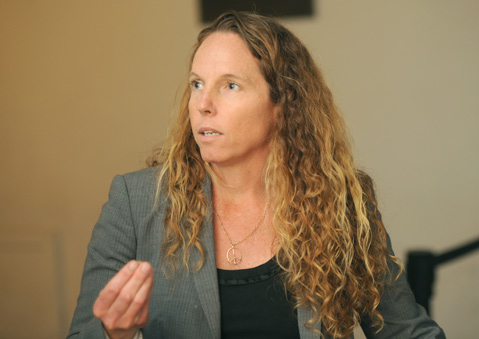Judge Strikes Down Gang Injunction
Rules Residents Aren’t ‘Prisoners in Their Own Homes’

There were no ifs, ands, or buts in Judge Colleen Sterne’s unequivocal ruling that Santa Barbara city police and prosecutors failed to make the case necessary to support the gang injunction they’ve been seeking since March 11 three years ago. Sterne faulted the gang-related data presented by various experts with the Police Department throughout the course of the 15-day trial — which officially began on Cinco de Mayo — as “flawed, unreliable, and incomplete.”
Likewise, Sterne wrote in the 32-page opinion she released Monday afternoon that she regarded the prosecution’s expert witness — attorney Gregory Anderson from Fresno and author of many gang injunctions — as “unpersuasive” in his conclusion that Santa Barbara would benefit from an injunction. Gang injunctions, she noted, are “highly particular” to their locales, and Anderson was hampered by an “incomplete” understanding of Santa Barbara.

As for the prosecution’s most dramatic witness, Arthur Nevarez — an ex-shot-caller with an Eastside gang whom prosecutors had graphically dubbed “Mister X” — Sterne was most outspokenly critical. Nevarez had testified that the Mexican Mafia’s influence on day-to-day gang activity in Santa Barbara had been growing, claiming at one point — in what Sterne described as “a rather gratuitous statement” — that, “Word went around the jail that things should lay low to let the gang injunction cool off.”
Sterne noted that Nevarez — now serving a life sentence — had admitted he’d “manipulated the system” in getting assigned to County Jail and was seeking to strike a deal with authorities. She dismissed his testimony as “obviously self-serving,” adding, “He seemed highly interested in demonstrating his own self importance, and highly invested in his own notoriety and gang notoriety. The court questions his credibility.”
Sterne readily acknowledged that Santa Barbara has rival criminal street gangs and that their behavior constitutes a genuine problem. But, she stressed, that behavior does not rise to the level of “substantial and unreasonable nuisance,” which the law requires for purposes of imposing a gang injunction or carving out “safety zones,” in which those named would be barred from associating with one another, wearing certain clothes, hanging out in parks, or enjoying what would otherwise be constitutionally protected behavior.
“There is no evidence that residents of the proposed Safety Zones in Santa Barbara are prisoners in their own homes, remain indoors at night, prevent their children from playing outside, or whose relatives and friends refuse to visit,” Sterne wrote in conclusion.
Police and prosecutors, she said, failed to provide any witnesses to testify that they felt otherwise. By contrast, the team of defense attorneys representing those named in the injunction called four downtown residents — one a former gang member and now an activist fighting the injunction — who testified about the lack of fear they felt when walking about downtown.
For Sterne, that lack of broader community fear proved central to her ruling. Yes, she acknowledged, gang members target one another for assault, mayhem, and, on occasion, murder. The broader community, she stated, is generally spared the collateral impact. Gang code, she noted, dictates that the violence be confined to active participants. As result, she said, “The general community does not experience crime in the same way.”
Sterne also took exception to police claims that traditional law enforcement methods are inadequate to respond to the threat to public order posed by gangs. In fact, she argued that the success police have had enjoyed combating gang violence has “thwarted” their desire for an injunction. Gang crime, Sterne wrote, comprises a very small percentage of Santa Barbara’s total criminal activity and is much lower than in comparable cities. By contrast, Sterne said the safety zones proposed — which encompassed most of the east side, the west side, and downtown areas of Santa Barbara — were too large. Not only did they fail to meet legal requirements that they be “narrowly tailored,” but she expressed doubt they could be tailored at all.
She was much impressed by the testimony of UCSB Professor Edwina Barvosa, the expert witness for the defense, who argued that gang injunctions typically have very limited and exceedingly short-term benefit. Barvosa warned that in some situations, gang injunctions can create “blow-back,” perpetuating an “us-versus-them” attitude between law enforcement and Latino communities. More than once, Sterne noted the lack of public input and community buy-in before Police Chief Cam Sanchez, District Attorney Joyce Dudley, and Santa Barbara Mayor Helene Schneider first announced they were pursuing the injunction.
At that time, Sanchez said the injunction was targeting 30 adult gang members, whom he described as “the worst of the worst.” Just before trial, however, that number was reduced to only 11. But even that, Sterne ruled, was one too many. In the case of Francisco Anaya, Sterne said there was no “clear and convincing proof of current gang membership.”
When the injunction was first proposed, Santa Barbara was coming off a wave of gang violence that left at least three noncombatants dead. Since then, the level of gang-related crime has abated substantially, and support within the City Council is far less robust than it first was. Holding up implementation has been a shifting team of defense attorneys, but always at the nucleus there was Tara Haaland-Ford and Steve Dunkle.
“I’m elated. I’m floating, “ said Haaland-Ford. “Maybe now, both sides can start working together and putting resources into programs that actually help.” She said she’d been notified by the ACLU that this is the first time the defense has prevailed against a proposed gang injunction anywhere in the United States. (Other key attorneys involved in the defense were Michael Hanley, William Makler, James Crowder, and Neil Levinson.)
Mayor Helene Schneider, who has taken considerable heat from her political base, commented, “I respect the court process. The City of Santa Barbara will continue to use every tool available to keep our residents and visitors safe while we consider the impacts and options of Judge Sterne’s ruling.” Senior prosecuting attorney Hilary Dozer, who did most of the heavy lifting in Sterne’s courtroom, said he got to present the best case he had in favor of the injunction. “She did a good job and a fair job,” he said of Sterne’s conduct of the trial. “Obviously I’m disappointed by her decision, but am I crying about it? Win, lose or draw, we got to put on our case. That’s all you can ask for.”
—



